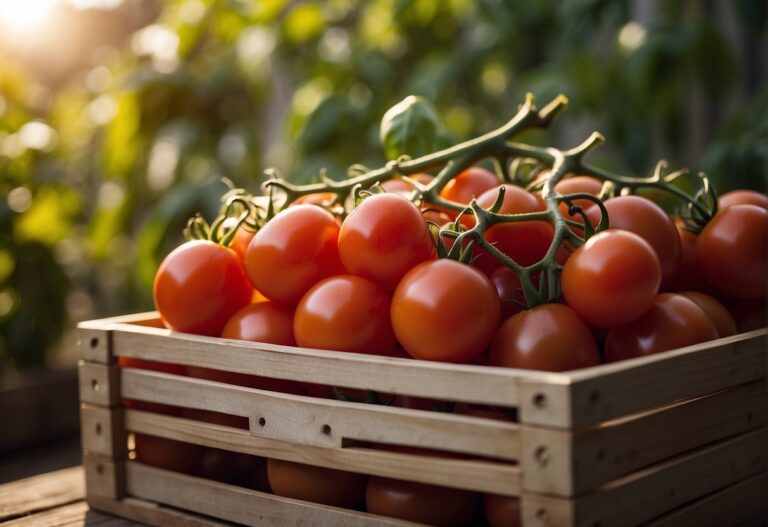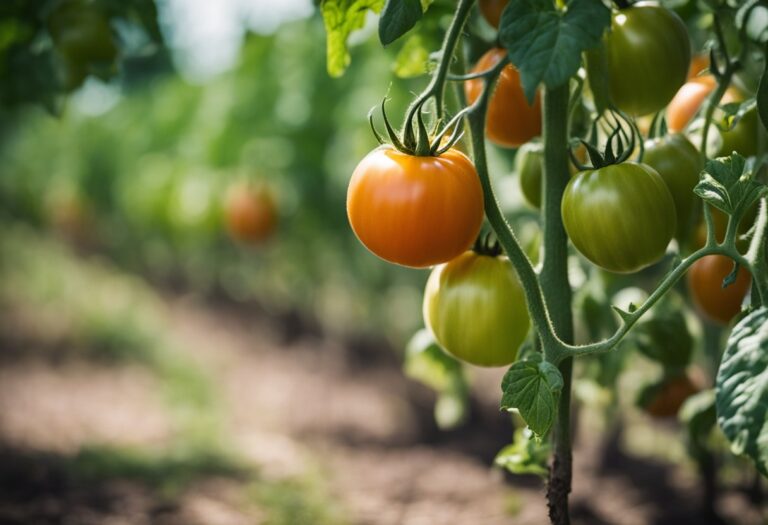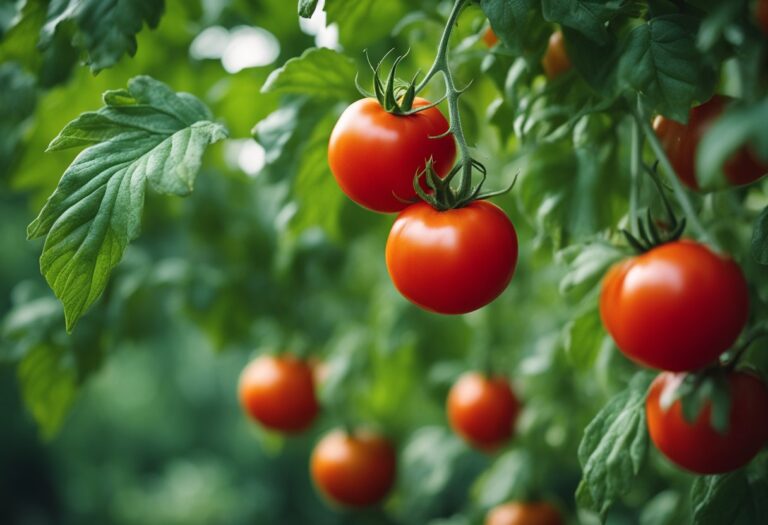Buying a Tomato Plant: Tips and Tricks for a Successful Harvest
Are you thinking about buying a tomato plant? Whether you’re a seasoned gardener or a beginner, growing your own tomatoes can be a rewarding experience. With so many types of tomato plants available, it can be overwhelming to choose the right one. In this article, we’ll guide you through the process of buying a tomato plant so you can enjoy fresh, juicy tomatoes all summer long.

Choosing the right tomato plant is essential for a successful harvest. Consider factors such as the size of your garden, the amount of sunlight it receives, and your personal taste preferences. Some popular varieties include cherry tomatoes, beefsteak tomatoes, and heirloom tomatoes. Once you’ve decided on the perfect type of tomato, it’s time to find a reputable seller.
Where you buy your tomato plant can make a big difference in its health and quality. Look for a seller that offers healthy, disease-free plants. You can buy tomato plants online or at a local garden center. Some sellers even offer organic or non-GMO options. With these tips in mind, you’ll be well on your way to growing delicious tomatoes in your own backyard.
Key Takeaways
- Choosing the right tomato plant is crucial for a successful harvest.
- Look for a reputable seller that offers healthy, disease-free plants.
- Consider factors such as sunlight, garden size, and personal taste preferences when selecting a tomato plant.
Choosing the Right Tomato Plant

When choosing a tomato plant, there are a few important factors to consider. By understanding the differences between determinate and indeterminate varieties, hybrid and heirloom plants, and how climate and seasonality affect tomato growth, you can make an informed decision and select the best plant for your garden.
Determinate vs. Indeterminate Varieties
Determinate tomato plants grow to a certain height and then stop growing, while indeterminate tomato plants continue to grow and produce fruit throughout the growing season. Determinate varieties are great for small spaces or container gardening because they don’t require as much support and tend to produce their fruit all at once. Indeterminate varieties, on the other hand, tend to produce a higher yield and have a longer growing season.
Hybrid vs. Heirloom
Hybrid tomato plants are created by cross-breeding different varieties to produce a plant with desirable traits such as disease resistance, higher yield, or improved flavor. Heirloom tomato plants, on the other hand, are open-pollinated and have been passed down through generations of gardeners. While heirloom tomatoes often have unique and delicious flavors, they can be more susceptible to disease and pests.
Understanding Climate and Seasonality
Tomatoes are warm-season plants and require plenty of sunlight and warmth to grow and produce fruit. When selecting a tomato plant, it’s important to consider your climate and the length of your growing season. If you live in a cooler climate, look for varieties that mature quickly or can be grown in a greenhouse. If you have a short growing season, choose early-maturing varieties that can produce fruit before the first frost.
In summary, choosing the right tomato plant involves considering the differences between determinate and indeterminate varieties, hybrid and heirloom plants, and the climate and seasonality of your location. By taking these factors into account, you can select a tomato plant that will thrive in your garden and provide you with a bountiful harvest.
Where to Buy Tomato Plants

If you are looking to buy tomato plants, there are several options available to you. In this section, we will discuss three popular places to purchase tomato plants: local nurseries and garden centers, online plant retailers, and farmers’ markets.
Local Nurseries and Garden Centers
One of the best places to buy tomato plants is your local nursery or garden center. These stores often carry a wide variety of tomato plants, including heirloom and hybrid varieties. You can also get advice from the staff on which plants will grow best in your area and how to care for them.
When shopping at a local nursery or garden center, be sure to check the quality of the plants. Look for plants that are healthy, with no signs of wilting or disease. You should also check the soil to make sure it is moist but not waterlogged.
Online Plant Retailers
Another option for purchasing tomato plants is online plant retailers. These retailers offer a wide variety of plants, including rare and hard-to-find varieties. You can also shop from the comfort of your own home and have the plants delivered directly to your doorstep.
When shopping online, be sure to read reviews from other customers to ensure that the retailer is reputable. You should also check the shipping policies and make sure that the plants will be shipped at the right time for planting in your area.
Farmers’ Markets
Finally, farmers’ markets are a great place to buy tomato plants. Local farmers often sell their own seedlings, which are grown in the same climate and soil conditions as your area. This can make them more likely to thrive in your garden.
When shopping at a farmers’ market, be sure to arrive early for the best selection. You should also ask the farmer about the variety of tomato plant you are interested in, and how to care for it.
Preparing for Planting
Before you buy a tomato plant, there are a few things you should do to prepare for planting. In this section, we’ll go over some tips for selecting the right soil, choosing a location, and deciding between a pot or a garden bed.
Selecting the Right Soil
Tomatoes need well-draining soil that is rich in nutrients. You can buy potting soil specifically formulated for tomatoes, or you can make your own by mixing equal parts of compost, peat moss, and vermiculite or perlite. Adding organic matter, such as compost or aged manure, to your soil can also help improve its texture and fertility.
Choosing a Location
Tomatoes need at least six to eight hours of direct sunlight each day, so it’s important to choose a location that gets plenty of sun. They also need protection from strong winds, so planting them near a fence or wall can help provide some shelter. If you’re planting in a garden bed, make sure the soil is well-draining and has good air circulation.
Pot vs. Garden Bed
Deciding whether to plant your tomato in a pot or a garden bed depends on your space and preferences. If you have limited space or want to grow tomatoes on a balcony or patio, a pot may be your best option. Choose a pot that is at least 18 inches in diameter and has drainage holes in the bottom. If you’re planting in a garden bed, make sure the soil is well-draining and has good air circulation. You can also add a layer of mulch around the base of your tomato plant to help retain moisture and suppress weeds.
By following these tips for preparing for planting, you’ll be well on your way to growing healthy and delicious tomatoes.
Caring for Your Tomato Plant
Now that you have bought your tomato plant, it’s important to know how to care for it properly. Here are some tips to keep your tomato plant healthy and productive.
Watering Requirements
Tomato plants need consistent watering to thrive. You should water your tomato plant deeply once a week, making sure the soil is moist but not waterlogged. You can also use a watering can or hose to water the plant’s base and avoid getting the leaves wet. During hot and dry weather, you may need to water your plant more frequently.
Fertilizing Tips
Tomato plants need nutrients to grow and produce fruit. You can fertilize your tomato plant with a balanced fertilizer every two weeks. Alternatively, you can use organic fertilizers like compost or manure. Be careful not to over-fertilize, as this can lead to excessive foliage growth and fewer fruits.
Pruning and Support
Tomato plants can become quite large and bushy, so it’s important to prune and support them. You can use stakes, cages, or trellises to support your tomato plant and keep it off the ground. This will also help prevent disease and pests. You should also prune your tomato plant regularly by removing the suckers that grow between the main stem and the branches. This will encourage the plant to focus its energy on producing fruit.
By following these simple tips, you can ensure that your tomato plant stays healthy and produces a bountiful harvest. Happy gardening!
Common Pests and Diseases
If you’re growing tomato plants, you’ll need to be aware of the pests and diseases that can affect them. Here are some common issues you might encounter and how to deal with them.
Identifying Common Issues
Tomatoes can suffer from a variety of pests and diseases. Here are a few of the most common:
- Aphids: These small insects can suck the sap from your tomato plants and cause them to wilt. You can use a strong spray of water to knock them off your plants, or use an insecticidal soap to kill them.
- Whiteflies: These tiny insects can also suck the sap from your plants and spread disease. You can use sticky traps to catch them or use a neem oil spray to repel them.
- Hornworms: These large caterpillars can eat the leaves of your tomato plants and damage the fruit. You can handpick them off your plants or use Bacillus thuringiensis (BT) to kill them.
- Early Blight: This fungal disease can cause brown spots on the leaves of your tomato plants and weaken them. You can prevent it by planting disease-resistant varieties and spacing your plants out to improve air circulation.
- Blossom End Rot: This is a physiological disorder that causes the bottom of your tomato fruit to turn black and mushy. It’s caused by a calcium deficiency in the plant. You can prevent it by ensuring your plants get enough water and nutrients.
Organic Pest Control
If you’re growing tomatoes organically, you’ll want to avoid using chemical pesticides. Here are some organic pest control methods you can try:
- Companion planting: Certain plants, like marigolds and basil, can repel pests and attract beneficial insects to your garden.
- Diatomaceous earth: This is a natural powder made from the fossilized remains of tiny aquatic organisms. It can kill pests like aphids and whiteflies by dehydrating them.
- Garlic spray: You can make a natural insecticide by crushing garlic cloves and mixing them with water. Spray this on your plants to repel pests.
- Beneficial insects: You can attract beneficial insects like ladybugs and lacewings to your garden by planting flowers they like and avoiding the use of pesticides.
Disease Prevention
Preventing diseases in your tomato plants is key to keeping them healthy. Here are some tips to help you avoid common tomato diseases:
- Plant disease-resistant varieties: Look for tomato plants that are resistant to common diseases like early blight and verticillium wilt.
- Rotate your crops: Don’t plant tomatoes in the same spot every year. This can help prevent the buildup of disease in the soil.
- Water properly: Overwatering or underwatering your plants can stress them and make them more susceptible to disease. Water deeply and regularly, but don’t let your plants sit in water.
- Keep your garden clean: Remove any diseased or dead plant material from your garden to prevent the spread of disease.
Frequently Asked Questions
What is the best variety of tomato plant to purchase for my garden?
There are many varieties of tomato plants available for purchase, each with its unique characteristics. Some popular varieties include Beefsteak, Cherry, Roma, and Heirloom. The best variety of tomato plant for your garden depends on your preferences and needs. Consider factors such as taste, size, and disease resistance when selecting a variety.
When is the ideal time of year to plant tomatoes?
Tomatoes are warm-season plants that thrive in temperatures between 70-80°F. The ideal time to plant tomatoes varies depending on your location, but generally, it is recommended to plant them after the last frost in the spring. In warmer climates, tomatoes can be planted in the fall.
How long does it take for a tomato plant to start producing tomatoes?
The time it takes for a tomato plant to start producing tomatoes varies depending on the variety and growing conditions. Generally, it takes around 60-80 days from planting for a tomato plant to start producing fruit. However, some varieties may take longer.
Should I start with tomato seeds or young plants for my garden?
Starting with young plants is generally easier and more reliable than starting with seeds. Young plants are already established and have a better chance of surviving and producing fruit. However, starting with seeds can be more cost-effective and allows you to choose from a wider variety of plants.
Where can I find healthy tomato plants for sale in my area?
You can find healthy tomato plants for sale at your local garden center, nursery, or home improvement store. You can also purchase them online from reputable sellers. Be sure to choose plants that are free from pests and diseases and have strong stems and healthy leaves.
What should I look for when choosing a tomato plant to ensure good health and yield?
When choosing a tomato plant, look for plants that have a sturdy stem, healthy leaves, and no signs of pests or diseases. Avoid plants that are too tall or leggy, as they may have been grown in poor conditions. Choose plants that are appropriate for your growing conditions and have a good root system.



